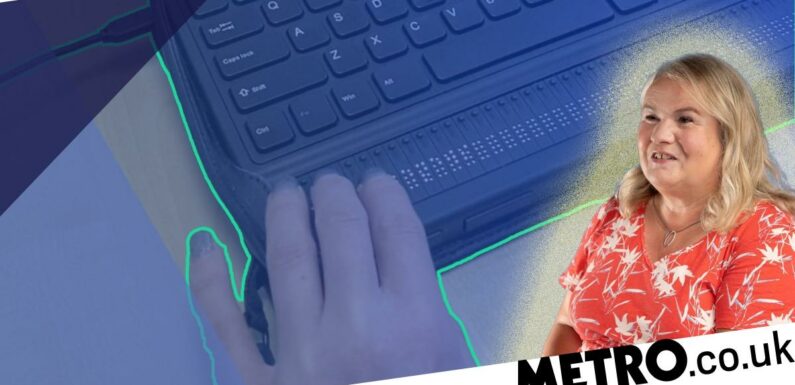
In order to write this article, I am using the tech this very piece is about.
It’s something called the Mantis Q40 and it’s a refreshable Braille display. This device allows me to interact with my computer using Braille.
Braille is a reading and writing system of raised dots, which are read by touching them with your fingertips. I use it because I’m blind.
I first started using Braille at eight years old after my sight became too poor to read and write using traditional methods. The Mantis Q40 is a far cry from the Braille I used as a child.
The Mantis Q40 is a device about the size of a sheet of A4 – most of the space is taken up by a QWERTY keyboard but at the bottom is a row of 40 refreshable Braille cells.
Each cell consists of eight pins arranged in two columns and four rows. These pins move up and down electronically to create different combinations called Braille symbols.
These symbols correspond to letters, numbers, and punctuation marks displayed on my computer screen.
Essentially, the Mantis allows me to both touch type using the QWERTY keyboard and read the contents of a screen by touch in Braille.
It’s a game changer – I can’t imagine doing my job without it
All this is a very roundabout way of saying that I have a line of Braille which changes under my fingers as I work, enabling me to take in information as I type, or look up and read stored information.
I use it all day, every day. I couldn’t do my job at Guide Dogs without Braille.
Refreshable Braille is surprisingly old technology, developed by a company in Germany called Papenmeier in 1975. I first came across it aged 17 in 1982 when a machine called a VersaBraille was loaned to my school.
It was a standalone machine. You could input data using a Braille keyboard and it stored what you wrote on a cassette.
It acted as a note taker, as you could read stored information back at any point by way of a small refreshable Braille display. I was blown away!
Imagine being able to write Braille without the very bulky paper I was used to.
VersaBrailles were far too expensive for the school to buy – one teacher pointed out that you could have bought a family car for the price of one.
But it was to be a pipe dream and I would not be fortunate enough to own a Braille display until late 1993.
To view this video please enable JavaScript, and consider upgrading to a webbrowser thatsupports HTML5video
Until then, I persevered with Braille paper, which was very thick, more like a thin card, and it wasn’t unusual to have stacks of notes at school, five or six inches thick.
The first model I used cost almost £7,000, paid for through the government’s Access to Work scheme. It was by ALVA and was a large platform with a line of Braille display and nothing else. I had a standard QWERTY keyboard that sat separately.
It was massive – probably three times the size of the Mantis and incredibly heavy. Certainly not portable.
Since 1993, I have worked in various customer facing roles where I would have struggled without Braille.
There are those who use text-to-speech software: technology that reads out loud what is on screen. While I take my hat off to them and their ability to decipher the different voices in their headsets and remain sane, I couldn’t use that.
For the last six years I have worked for Guide Dogs, a charity close to my heart as I have a beautiful German Shepherd cross Golden Retriever guide dog called Elsa. She is my seventh guide dog since I got my first in 1989 and I couldn’t be without her.
I work on the ‘Guide Line’ as a Dog Health Advisor, speaking to service users and volunteers and advising on health issues with working guide dogs, retired dogs, or puppies in training.
This is where my Mantis Q40 comes into its own.
It’s a totally versatile piece of kit which has opened up the written world in ways I could never have imagined
Unlike the other Braille displays I have used, which were much larger and less portable – the Mantis is a Bluetooth QWERTY keyboard with a built-in refreshable Braille display, meaning a less cluttered and more comfortable experience ergonomically.
It’s an all-in-one solution, whereas previously, people with a vision impairment had to carry both a traditional keyboard and a separate braille device.
While speaking to callers, I often have to look things up on my computer. If I’m listening to someone speak and want to read information at the same time, I can’t have a screen reader talking to me simultaneously, so my Mantis keyboard allows me to read the information on screen while having a conversation on the phone.
It also means when I am making notes or recording information during a call, I can quickly check the accuracy of what I have typed by reading it back in Braille.
It’s a game changer – I can’t imagine doing my job without it.
It’s not cheap at around £2,500. Thankfully, again using the Access to Work scheme and with help from my employer, I was able to get one.
Since then, I’ve been lucky enough to have one and it does all the things I’d hoped for. It fits nicely in my backpack so I take it wherever I go.
An added bonus is that it also connects to iOS devices such as my iPhone. It means I can access thousands of books on the Kindle app and read them in Braille – something blind people could only dream of until around 10 years ago.
I even used it to read a poem at the service when my father sadly passed away in 2021.
It’s a totally versatile piece of kit which has opened up the written world in ways I could never have imagined.
I am a true advocate of Braille and would urge any blind or partially sighted person who thinks they might benefit from Braille to go ahead and learn it.
In my ideal world, blind children would all learn it at school. To me, it’s the difference between being read to and actually reading for myself.
There’s amazing tech out there for people with a vision impairment and I’m lucky to own just one piece of it – it has truly changed my life.
Visit Guide Dogs’ Tech Hub to learn more: www.guidedogs.org.uk/techhub
The Tech I Can’t Live Without
Welcome to The Tech I Can’t Live Without, Metro.co.uk’s new weekly series where readers share the bit of kit that has proved indispensable for them.
From gadgets to software, apps to websites, you’ll read about all manner of innovations that people truly rely on.If you have a bit of tech you can’t live without, email [email protected] to take part in the series
Source: Read Full Article

